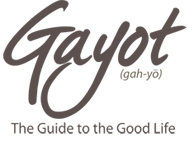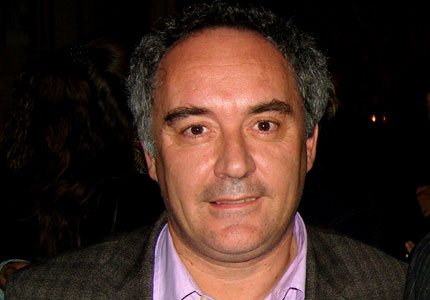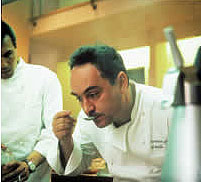Editor's Note: elBulli closed in July 2011Ferran Adrià - elBulli restaurantAdrià's Audacity
Ferran Adrià, the much-discussed Spanish chef, was proclaimed the number one cook in the world by a British magazine. However, not everyone agrees with this extraordinary distinction bestowed upon a cook whose preparations are disorienting to some educated palates, to say the least. Is Adrià a difficult-to-understand genius or is he just blowing hot air over the blue Mediterranean waters to generate waves of celebrity? Here is our take on the controversy. In Spain, and particularly his native region of Catalonia, superchef Ferran Adrià's face is everywhere. From basic instructional videos and mammoth tomes that sometimes serve more as eye candy than reference tools, he has become a national hero. Adrià is possibly the most famous chef in the world right now, which does not necessarily mean the best, but his creations at elBulli in the tiny town of Rosas are certainly among the most coveted. For the six months a year that elBulli is open, Adrià, 44, brings clients from around the world to their knees with a style that blends sci-fi creativity with an essence of the Mediterranean. In the land of Salvador Dalí, Adrià works to expose, magnify and even remake the heritage of the meager local cooking.
With the help of fifty young Spanish cooks, he prepares a menu dégustation for an equal number of diners wild-eyed with excitement. The €175 dinner gets started on Spanish time (read: late) when a dozen appetite-whetting "snacks" (a wildly underwhelming moniker) are presented to those lucky enough to get in. Adrià's kitchen, shall we say laboratory, then sends out nine "tapas," followed by four main dishes and no less than three desserts. The menu highlights seafood and vegetables while giving short shrift to meat. In all there are a mind-boggling 28 different presentations that feature different cooking styles with contrasting and surprising flavors and textures. Among his creations are frozen whisky sour candy, cocoa butter with crispy ears of rabbit, and Kellogg’s paella, which consists of Rice Krispies, shrimp heads and vanilla-flavored mashed potatoes. For both the restaurant staff and their diners, it's an acrobatic exercise with fascinating results. One thing’s for sure: with an amazing 1,400 serving plates per service, the dishwashers must rank among the world’s best.
Adrià is chock-full of new techniques, which are the hallmarks of 21st century cuisine for him. Grinders, box cutters, emulsifiers and even siphon bottles allow him to investigate new creative processes. Among his favorite tools is the pacojet, which mixes and purees deep frozen ingredients without thawing them to produce a frozen and intensely natural tasting mousse. For example, his "quinoa of foie gras with consommé," in which the liver is puréed, frozen, then spat from the pacojet in pebbly bits to which diners add a shot of concentrated bouillon. This dish, along with his other pacoitized creations including white garlic and almond sorbet and tobacco-flavored blackberry crushed ice, are stunning. Adrià’s cuisine is in essence based on the work of wildly-underappreciated French "molecular gastronomist" Hervé This. His "deconstructionist" style also harkens back to Spain's modernist chefs in the 1880s who tried unsuccessfully to create a “cubist” cuisine before the country dropped off the culinary map. A Catalan at heart, Adrià is as audacious as his unsuccessful predecessors. Here, cooking creativity wants to be interpreted as a response to social and cultural challenges. His risk-taking contemporaries working in American kitchens include Homaro Contu, chef/owner of Moto in Chicago, and Ludovic Lefebvre, formerly at L’Orangerie and Bastide in Los Angeles.
One of Adrià’s keys is to "adapt classic dishes to new styles" which can be seen with his caramelized quail's egg or cold ravioli with fennel and tofu. When you expect to eat a civet of rabbit, instead you end up with a chocolate sauce and a hot gelatinous apple on your plate. Unlike the work of top French chefs like Marc Veyrat, Adrià's cuisine, which has shades of abstraction and minimalism, is rarely considered gourmand or sensual. While many of his recipes have been filtered through the sieve of “deconstruction,” some gourmets may find it difficult to swallow his dishes, like the raw squid in his ink “à la brutesca.” There is no doubt that the contradictions in his cooking can end in discord. Could the bridge between tradition and innovation turn into a dead end? If Spain is not on your itinerary, you can learn more about the chef and the foundations of his inventive and much-lauded cooking style in his book "elBulli 1998-2002." Though it delves so deeply into those four years that it is filled with inside jokes only Adrià himself and his live-in employees in Rosas would understand, the overall vision is like a meditation on his museum-quality production. One subject that Adrià broaches is his "sixth sense" work—a sort of wild effort to put one ingredient into the fore. For example, with his sorbet of grilled corn, Adrià pulls off a bizarre mix of fire and ice that must be tasted to be truly appreciated. If food is also entertainment, Ferran Adrià's show at elBulli is worth the trip. * Images by Francesco Guillamet, courtesy of elBulli
Related Content:
|

















